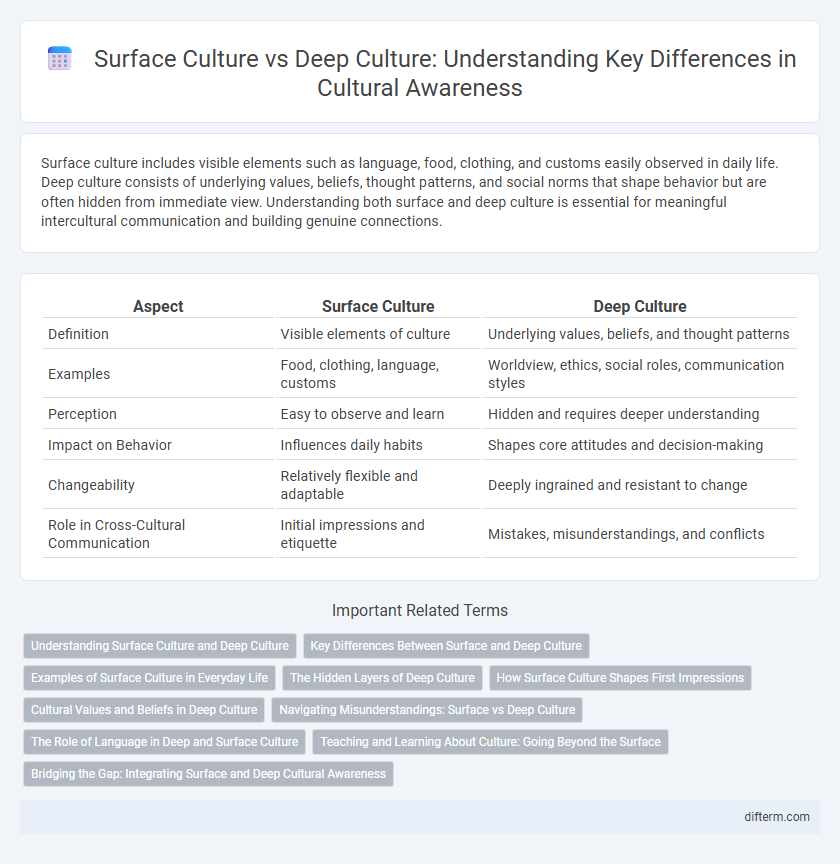Surface culture includes visible elements such as language, food, clothing, and customs easily observed in daily life. Deep culture consists of underlying values, beliefs, thought patterns, and social norms that shape behavior but are often hidden from immediate view. Understanding both surface and deep culture is essential for meaningful intercultural communication and building genuine connections.
Table of Comparison
| Aspect | Surface Culture | Deep Culture |
|---|---|---|
| Definition | Visible elements of culture | Underlying values, beliefs, and thought patterns |
| Examples | Food, clothing, language, customs | Worldview, ethics, social roles, communication styles |
| Perception | Easy to observe and learn | Hidden and requires deeper understanding |
| Impact on Behavior | Influences daily habits | Shapes core attitudes and decision-making |
| Changeability | Relatively flexible and adaptable | Deeply ingrained and resistant to change |
| Role in Cross-Cultural Communication | Initial impressions and etiquette | Mistakes, misunderstandings, and conflicts |
Understanding Surface Culture and Deep Culture
Surface culture includes visible elements like language, clothing, cuisine, and customs, which shape initial impressions in cross-cultural interactions. Deep culture encompasses underlying values, beliefs, thought patterns, and social norms that govern behavior and communication but remain largely unconscious to outsiders. Understanding both surface and deep culture enhances cross-cultural competence and fosters meaningful connections by revealing the reasons behind observable cultural expressions.
Key Differences Between Surface and Deep Culture
Surface culture includes visible elements such as language, clothing, food, and customs that are easily observed and shared among members of a group. Deep culture encompasses underlying values, beliefs, thought patterns, attitudes, and social norms that shape behavior and perspectives but remain largely unconscious and less accessible. Understanding key differences reveals that surface culture represents external expressions, while deep culture forms the intrinsic foundation influencing identity and decision-making.
Examples of Surface Culture in Everyday Life
Surface culture includes visible elements such as language, clothing, food, and customs like greetings or festivals, which are easily observed in daily interactions. Examples include traditional attire worn during national holidays, popular cuisine enjoyed at family gatherings, and common holiday celebrations like Christmas or Lunar New Year. These external aspects reflect cultural identity but often conceal deeper values, beliefs, and social norms underlying the culture.
The Hidden Layers of Deep Culture
Deep culture encompasses the hidden layers of values, beliefs, and thought patterns that shape behavior and social norms beyond visible customs and traditions. These underlying elements influence perceptions of time, communication styles, and interpersonal relationships, often remaining unconscious to both insiders and outsiders. Understanding deep culture is essential for meaningful cross-cultural interactions and overcoming misunderstandings in global contexts.
How Surface Culture Shapes First Impressions
Surface culture, including language, clothing, food, and visible customs, plays a crucial role in forming immediate impressions during initial encounters. These observable elements provide quick cues about a person's cultural background, influencing perceptions of identity and behavior. Understanding surface culture helps navigate social interactions effectively, although it only scratches the surface of deeper cultural values and beliefs.
Cultural Values and Beliefs in Deep Culture
Deep culture encompasses the fundamental cultural values and beliefs that shape individual behavior and societal norms, often operating subconsciously within a community. These core assumptions influence attitudes toward family, authority, spirituality, and social roles, providing a stable framework for interpreting the world. Understanding deep culture is essential for effective intercultural communication and fostering genuine cultural empathy beyond superficial customs and traditions.
Navigating Misunderstandings: Surface vs Deep Culture
Navigating misunderstandings between surface and deep culture requires recognizing that surface culture includes visible elements like language, dress, and customs, while deep culture encompasses underlying values, beliefs, and thought patterns. Misinterpretations often arise when individuals focus solely on surface culture, overlooking the complex emotional and cognitive layers that influence behavior in deep culture. Effective cross-cultural communication demands sensitivity to deep cultural norms alongside an understanding of surface expressions to bridge gaps and foster genuine connections.
The Role of Language in Deep and Surface Culture
Language serves as a key component in both surface culture and deep culture, shaping everyday communication and underlying values. Surface culture includes visible elements like dress, food, and social behaviors, while deep culture encompasses beliefs, thought patterns, and emotional expressions embedded in language. Understanding idioms, tones, and contextual meanings in a language reveals insights into a group's core values and worldview, highlighting the essential role of language in interpreting cultural depth.
Teaching and Learning About Culture: Going Beyond the Surface
Teaching and learning about culture requires moving beyond surface culture, which includes visible elements like food, clothing, and festivals, to deep culture encompassing underlying beliefs, values, social norms, and thought patterns. Understanding deep culture enhances cross-cultural communication, critical thinking, and empathy by revealing the context behind behaviors and traditions. Effective cultural education involves immersive experiences and reflective practices that connect learners to the implicit, often subconscious, cultural frameworks shaping human interactions.
Bridging the Gap: Integrating Surface and Deep Cultural Awareness
Bridging the gap between surface culture and deep culture involves recognizing visible customs such as language and dress while also understanding underlying values, beliefs, and social norms that shape behavior. Integrating surface and deep cultural awareness enhances cross-cultural communication, reduces misunderstandings, and fosters more meaningful intercultural relationships. Tools like cultural sensitivity training and immersive experiences help individuals navigate both explicit cultural expressions and implicit social cues effectively.
Surface culture vs deep culture Infographic

 difterm.com
difterm.com